 Aircraft Carrier (Built from 1978, service 1988-2013)
Aircraft Carrier (Built from 1978, service 1988-2013)
The Príncipe de Asturias, originally named Almirante Carrero Blanco, was a light aircraft carrier and former flagship of the Spanish Navy built in Bazán’s Shipyards and commissioned on 30 May 1988.
This was the first Spanish Carrier since many years, but the country more or less operated one since the 1920s. The first was the 1922 Dédalo, a reconverter coaler, and first to operate autogyros. The second was an ex-Independence class fast carrier, USS Cabot, exhumed to the mothballs and offered to Spain in 1967, at first on loan as Dédalo and later equipped with the AV-8S Matador, sold by August 1972, stricken in August 1989. The Principe de Asturias was planned as its replacement. A very interesting ship, it was largely based on the USN VSTOL Support Ship design (VSS) cancelled in 1972 and the Sea Control Ship (SCS) cancelled in 1974. Permanently assigned to the Alpha Group escorted by six Santa Maria-class frigates and logistic ships plus ASW corvettes they participated in many NATO exercizes and peace support operations in the Adriatic. She was retired due to defence cuts and decommissioned on 6 February 2013 without replacement. #coldwar #spanishnavy #armada #spanisharmada #spanishday #VSS #SCS
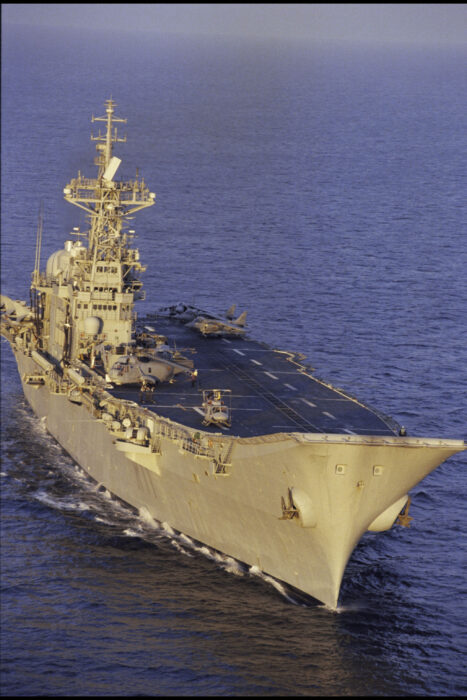
Dedalo underway with the sun going down and nice colors. src: https://www.nato.int/
Design of the class
Replacing the Dédalo
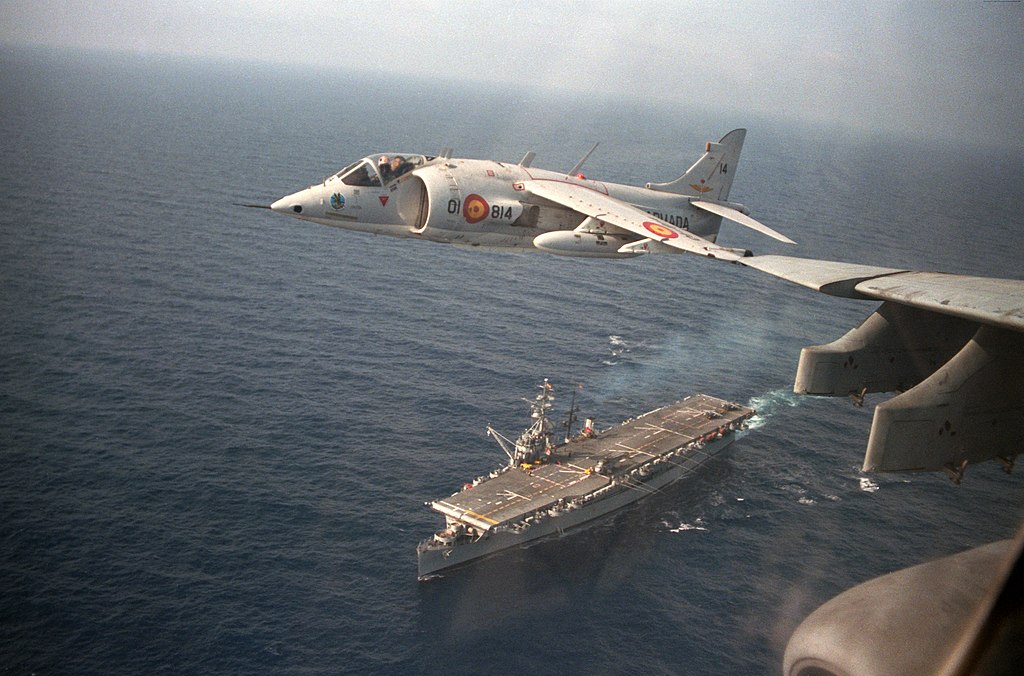
The previous Dédalo with a flyover by a Hawker Siddeley AV-8S Matador in June 1988
When Spain needed a new carrier, planned already for the future replacement of Dédalo, showing her age. To put things in context, Dédalo was the second of the name, the first was a 1920s balloon and seaplane carrier which helped testing air support in the Rif war and the first De La Cierva Autogyro flights from a ship. In 1967 Spain acquired a former Independence class Fast Carrier the former USS Cabot, in the mothballs and fully modernized. She was the very last of her class still in service in the 1980s, in fact she was discarded in 1989 but needed a replacement. She helped notably forging experience with VTOL aircraft and formed several generations of naval air pilots.
A US escort carrier design
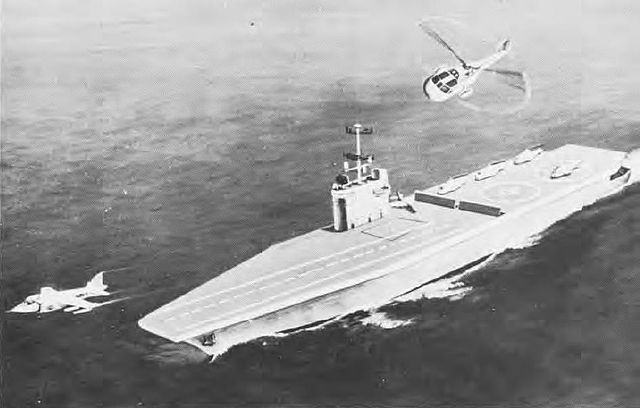 The design is basically that of the US Navy’s 1970s Sea Control Ship, modified with a ski-jump ramp added to better enable V/STOL aircraft takeoff, and other modifications to fit Spanish specifications. The SCS was a originally a projected small aircraft carrier conceptualized in 1969 under Chief of Naval Operations Elmo Zumwalt. These were essetnially a reboot of WW2 escort carriers to provid point defence, air support for convoys. It came after the realization that the costly supercarriers could not be spared to escort all convoys in a classic NATO scenario of a Soviet invasion of the West. The admiarlty wanted to built at least one ship to prove the concept, and have it on the shelf in case of war for mass duplication. The project however was canceled after budgetary cuts, in short, the Congress refused.
The design is basically that of the US Navy’s 1970s Sea Control Ship, modified with a ski-jump ramp added to better enable V/STOL aircraft takeoff, and other modifications to fit Spanish specifications. The SCS was a originally a projected small aircraft carrier conceptualized in 1969 under Chief of Naval Operations Elmo Zumwalt. These were essetnially a reboot of WW2 escort carriers to provid point defence, air support for convoys. It came after the realization that the costly supercarriers could not be spared to escort all convoys in a classic NATO scenario of a Soviet invasion of the West. The admiarlty wanted to built at least one ship to prove the concept, and have it on the shelf in case of war for mass duplication. The project however was canceled after budgetary cuts, in short, the Congress refused.
The original US SCS was “exotic” in that its air park was planned with Rockwell XFV-12 VTOL fighter aircraft and ASW helicopters. The first were shelved not long after.
 The concept would bounce again in 1974 with the VSS class, a specialized VTOL carrier now allowed by the proven Harrier, it was basically the same concept pushed again in an even more austere package, but still rejected again by the US Congress in 1975. The artist rendition shows a concept much closer to the final Spanish ship. Indeed this project was opposed by none other than Hyman G. Rickover and a great deal of officers that saw it as a prospective experiment which competed with other, more important investments and emergencies, especially in the context of post-Vietnam, oil crisis budget restrictions.
The concept would bounce again in 1974 with the VSS class, a specialized VTOL carrier now allowed by the proven Harrier, it was basically the same concept pushed again in an even more austere package, but still rejected again by the US Congress in 1975. The artist rendition shows a concept much closer to the final Spanish ship. Indeed this project was opposed by none other than Hyman G. Rickover and a great deal of officers that saw it as a prospective experiment which competed with other, more important investments and emergencies, especially in the context of post-Vietnam, oil crisis budget restrictions.
So in 1976, when the need to replace the Dédalo was expressed in Spain, many nautrally looked at the US as possible provider. Now WW2 hulls were all mothballed for too long to be of any use and many have been scrapped, so a more modern vessel was agreed upon. Several options were discussed, notably the acquisition of an Invincible class carrier which construction started in 1973. After all, they were an economical alternative and operated a composite VTOL/Helicopter group. There were discussions, but the Navy wanted a somehwat larger and “purer” design. At some point the shelved SCS and VSS projects, which went far in pre-design phase, were available and could cut down the design time back in Spain drastically. After some negociations in 1976, the USN “licenced” the design to the Spanish Government which gave the task of building the new ship to Empresa Nacional Bazán (now Navantia) in Ferrol.
The construction process started when the final design to meet Spanish requirements started on 29 May 1977. The order only came however on 1 March 1978 as the design was approved, and the keel was laid down on 8 October 1979. On 22 May 1982, in a ceremony presided over by Juan Carlos I of Spain, the launch took place, with Queen Sofía of Spain as the ship’s sponsor. Principe de Asturias made her first sea trials in November 1987. She was delivered to the Navy on 30 May 1988. No doubt these were good news for the USN as well as the cold war was at its hottest again a few years prior and the concept would have still be needed in case of war. Spain realized the concept and used it, sparing US taxpayers the expense. The Thai HTMS Chakri Naruebet delivered in 1997, was based on the Spanish ship’s design and not the SST/SCS, but is another example, even smaller, of a modern escort carrier.
Hull and general design

Prince de Asturias displaced 15,912 tons standard, for 16,700 tons loaded, an overall lenght of 195.9 m (643 ft) and a beam of 24.3 m (80 ft), with a draught of 9.4 m (31 ft). She had a hull ratio rather made for internal space than for speed, with a generous beam, a straight deck ending with the ski jump inergrated into a slightly angled bow. The hull ended aft with a bery broad transom stern, which space was divided between artillery posts and the main rear hangar lift. Its island, like the second, smaller lift were placed starboard, creating some free parking space, where also the deck tractors and a utility crane were located. The island was narrow apart the forward bridge on tow levels which overhanged the deck. On top forward was located the main derrick mast supporting the main aerials and antennae. Next was located the funnel, and after it the support structure for extra radars, notably a 3D radar under plastic radome for protection.
The ship had no utility boats but inflatable skiffs under davits on both sides and standard NATO encapsulated drop-type rescue boats.
Powerplant
The ship was powered by a system quite different from the steam turbines envisioned in the earlier US designs. Instead she had two Bazan-General Electric LM2500+ gas turbines in COGAG configuration, driving a single shaft for a 46,400 shp total output. This enabled her to reach a top speed of 26 knots (48 km/h; 30 mph). She also had a range of 6,500 nautical miles (12,000 km; 7,500 mi) at 20 knots (37 km/h; 23 mph).
Armament
The self-defense armament includes four close defense Meroka systems and six chaff decoy launchers. The ship relies on the capabilities of her embarked aircraft for strikes and for anti-submarine warfare, on the deported detection capacity and attack of her helicopters plus her escort battle group.
FABA Meroka Mod 2B CIWS
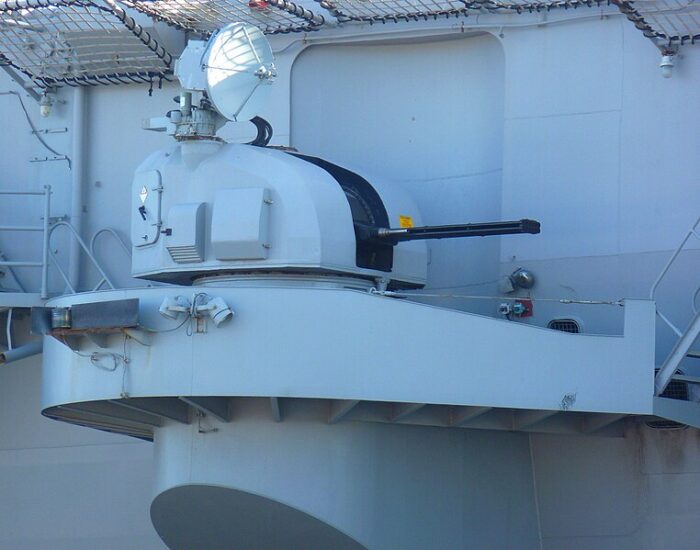
The Meroka CIWS was designed for the Spanish Navy using a 12 barrelled 20 mm in 2 rows of 6 guns each, non rotative, but firing in concert. It was worked out from 1980 and entered service in 1984 but is now due to replacement as production ceased. The last are still in service with the Santa María class ships, except the F-86 Canarias, swapping it for an anti-drone system in 2023.
“MeRoKa” is derived from German Mehrrohrkanone (“multi-barrelled gun”) developed and produced by FABA Sistemas (Fábrica de Artillería Bazán) with the guns provided by Rheinmetall.
These were placed in turrets, two at the poop, two on sponsons forward port and starboard.
Barrel system: 12 × Oerlikon 20 mm/120.
Weight: 4,500 kg (9,900 lb).
Elevation -15° to +85°, traverse 360°.
Muzzle velocity: 1,290 m/s (4,200 ft/s).
Rate of fire: 1,440 rounds per minute cyclic (for all twelve barrels).
Ammunition: Fixed (APDS-T) 720 rounds in a magazine, 60 rounds per barrel.
Weapons range: Effective range with APDS-T (0.102 kg with sabot), roughly 1,500–2,000 meters.
Search and track systems: Lockheed Electronics PVS-2 Sharpshooter I-band radar, Indra Thermal Imager.
Not present on all sources, it seems the only other guns aboard were saluting ones (conways).
Sensors
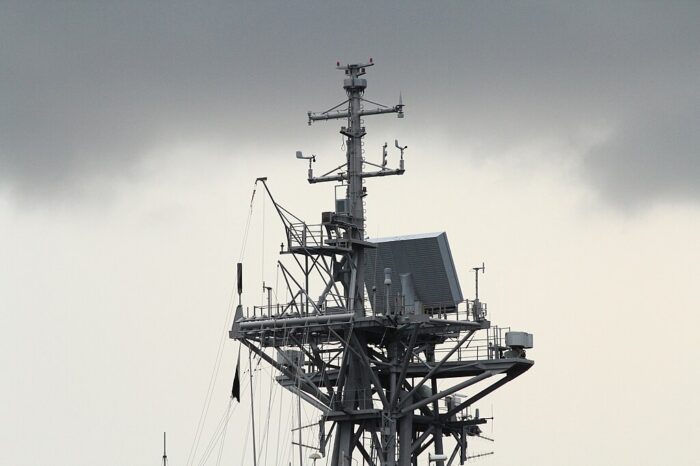
Raytheon SPS-52C/D 3D air search radar (ASR)
Shipborne 3-D long-range air surveillance radar on top of the derrick forward. Hughes development of the AN/SPS-39A.
Specs: FRQ 2 910 to 3 100 MHz (E/F-band), PRF 329 Hz, Pwd 1 µs, PP 330 kW, Range 240 nm (445 km) resolution 150 m, bwt 1.1°, 5 rpm.
SC Cardion SPS-55 surface search radar
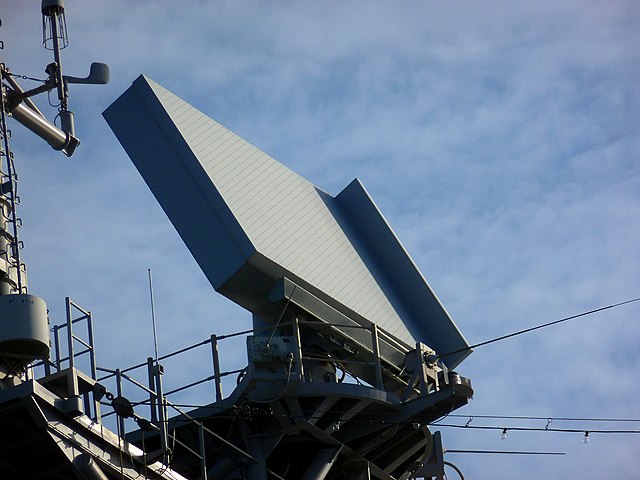
Solid state surface search and navigation radar developed by Cardion Electronics for the US Navy from 1971.
Specs: FRQ I band (9.05 to 10.0 GHz), Range 50 nm (92.6 km), Azimuth 1.5º -10° to +10°, PP 130-160 kW.
ITT SPN-35A aircraft control radar
Computerized automatic landing system made by ITT-Gilfillan for the Tarwa class LHA, helping with the landing and TO of helicopters and VTOL. Installed in the aft radome.
Specs: FRQ 9.0 to 9.2 GHz band, PRF 1200, pwt .2 ms, PP 200W.
FABA SPG-M2B fire control radar
Four of them, each on a Moroka CIWS unit, left side. Composed of a dish like array, on-mount Lockheed Electronics PVS-2 Sharpshooter I-band radar which to acquire targets at 5,000 m (5,500 yards), and completed by an optronic system as backup in a jamming environment with an off-boresight tracker and from the 2010s cupled with an Israeli designed IR tracker.
SELEX Sistemi Integrati RTN-11L/X missile approach warning radar
No data yet.
Selex RAN 12 L target designation radar
Another Italian navy system, operating in the L and X-band in dual frequency for air and surface surveillance. The antenna is roll and pitch stabilised with an X-band sub-system dedicated for detection of surface and low-flying targets.
Passive and active protection
Nettunel electronic countermeasures unit
Italian in origin (Nettuno) Spanish designed and built ECM. Also licenced to China and Israel. Tasked with radar detection and analysis, identification and jamming as part of a comprehensive EW family of modules. Scr
SRBOC
US standard mark 36 decoy launcher system. Likely Mod 2, 6 or 9 with 24 tubes in 4 launchers, 4 lockers, 80 spares. Installed on either side of the bridge.
Sensytech AN/SLQ-25 Nixie decoy
US standard anti torpeo decoy system intoduced in 1987. Likely installed at the poop. src
Air Facilities
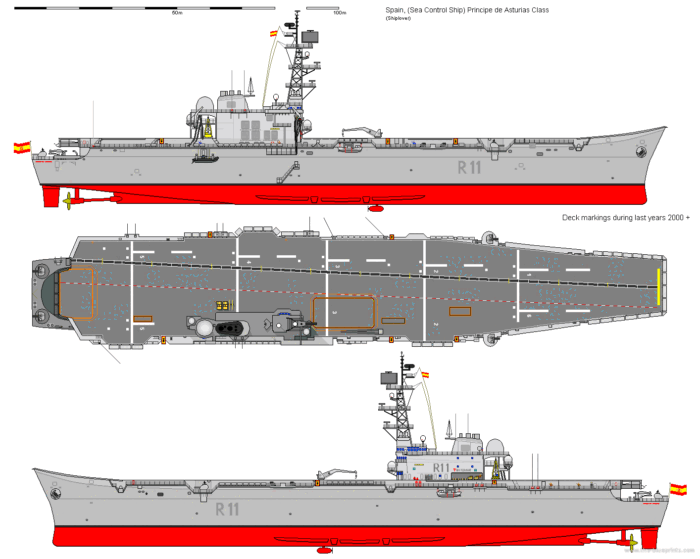
3 view (shipbucket (shiplover) via the-blueprints.com) showing her 2000s later deck markings
The ship is a STOBAR, not CATOBAR (Short Takeoff…) so without catapult aicraft carrier. This had advantages and inconvenients. The absense of catapult free deck space and required less complex machinery, while the ski jump combined with the straight deck still allow for simultaneous landings (vertically or short aft) and take-offs forward. However it is impossible to fully load a VTOL aircraft and expect it will take off without issue. This imposes a reduction in payload unlike catapult. In the case of Asturias, the characteristic “ski-jump” is angle 12° here, 46.5 m (153 ft) in length, with the runway sightly off the longitudinal axis, tilted portside. The hangar measures 2,398 m2 (25,811 sq ft) is accessed by two flight deck lifts. The 5,100 square metres (55,000 sq ft) flight deck is 176 metres (577 ft) in length.
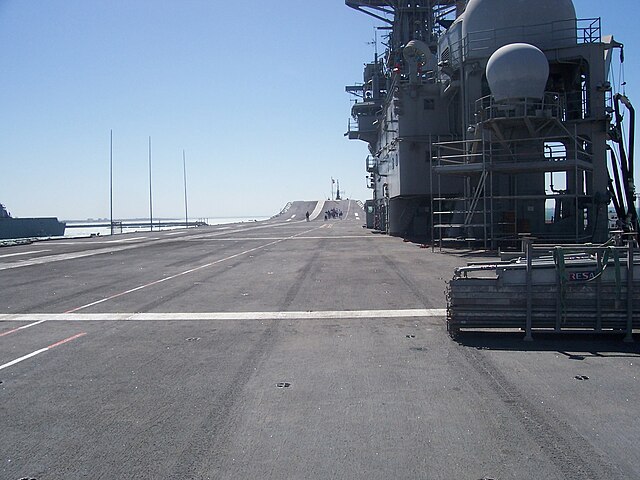
The 5,104 m² desck surface, about 176 × 29 m including elevators is complemented by the 2,250 m² of the hangar, about 109 × 22 m without closure, and occupying around 60 percent of the total length of the ship. In taxi mode, the carrier could thus carry up to 37 aircraft. It has two elevators for rapid operation between the hangar and flight deck: One is located near the island in the “parking” area, deported starboard so not to hamper flight deck operation. It is rectangular and large enough for a wings folded Harrier or a rotor folded Sea King helicopter or even larger. The aft elevator is cantilevered and placed at the end of the landing runway, at the tail end of the hangar.
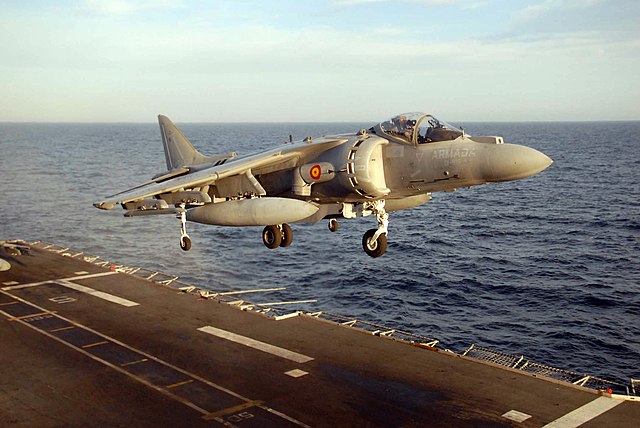
This arrangement allows simultaneous landings and take off from the aft and forward flight deck nearly at all times, with some parking space to starboard. The hangar also comprised a second level below used for aircraft spare parts with warehouses and workshops for contiunous maintenance, carried out day or night by shifts. The Harrier taks more space than helicopters so 17 could fit in the hangar, but probably around 20+ helicopters depending on the mission and model.
The key advantage of this small carrier is the use of V/STOL aircraft, giving it fast projection capability, notably for localized air support and long range air defense.
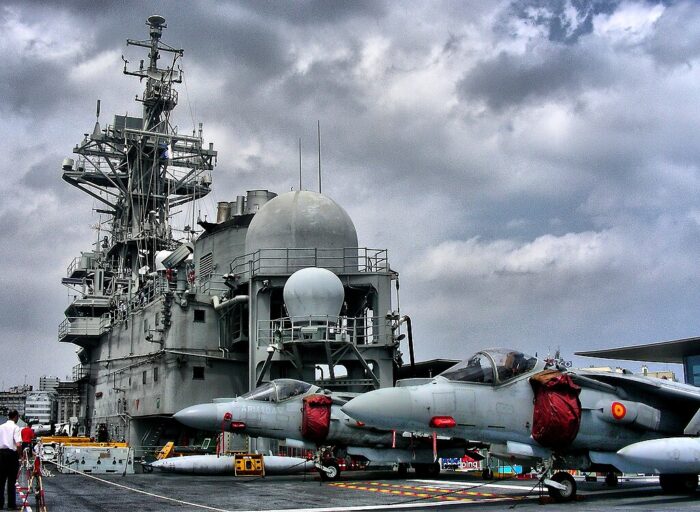
Deck of the aircraft carrier docked in the port of La Coruña, 2010
The typical air group amounts up a multi-role force of aircraft, with between ten to twelve AV-8 Harrier II and AV-8B Harrier II Plus, complemented by twelve helicopters, like in standard, six Sikorsky H -3 Sea King, two Sikorsky H-3 Sea King used for AEW (Air Early Warning) and four Agusta-Bell AB-212, plus for SAR, plane guard and liaison with the shore. Depending on the mission could be changed, like swapping Sea Kings for SH-60B helicopters for ASW search and destroy missions. She could also operate similar models from other nationalities, such as British and Italian Harriers as well of course, USMCs Harrier II.
Air Group
The air group of 29 fixed wing and rotary wing aircraft, about the same she would have in US service, when VTOLs where planned to complement her ASW park and defend the fkeet against long distance air threats. Due to the STOL, STOVL and VTOL capacity the off-center flight deck is 175.3 m long and that includes the 46.5 m long ramp or ski-jump achieving a greater launch speed and altitude for the engine to really kick off and allow rapid climb.
AV-8B Matador-II and II+
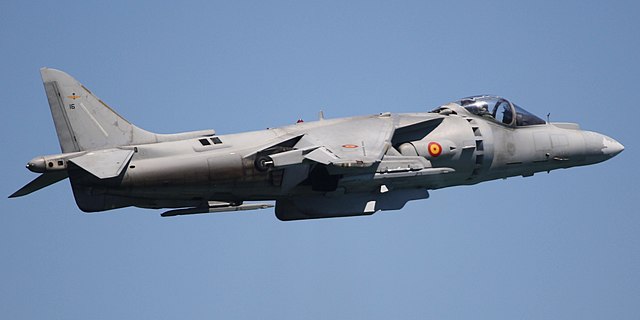
The 1st generation Harrier built by CASA as the Matador was ageing rapidly and as the ship was completed she was prepared to operate the EAV-8B Harrier II which was a Spanish version of the Harrier II in US service. The Spanish Navy was its first international customer, ordering 12 in 1983 to replace its AV-8S Matador. It was called Matador II. In 1993, eight AV-8B+ Harriers (EAV-8B+ in service) was followed by a decision in 2000 to upgrade the earlier jest to this standard.
Production of the AV-8B Harrier II Plus was conducted, in addition to McDonnell Douglas’ plant, at CASA’s facility in Seville, Spain. Production was authorized on 3 June 1992 with the maiden flight of the prototype made on 22 September, and flight-test program, first production model flying on 17 March 1993. Deliveries from April 1993 to 1995.
The Spanish Harrier fleet survived the decommission of the carrrier in 2013. They were flown by the 9 Escuadrilla at Rota AB, and started operating from the LHD Juan Carlos 1. 9 Escuadrilla made a last apparition at Air Tattoo 2019 and won the RIAT CEO Award, they were also seen at RIAT 2023.
SH-3D Sea King
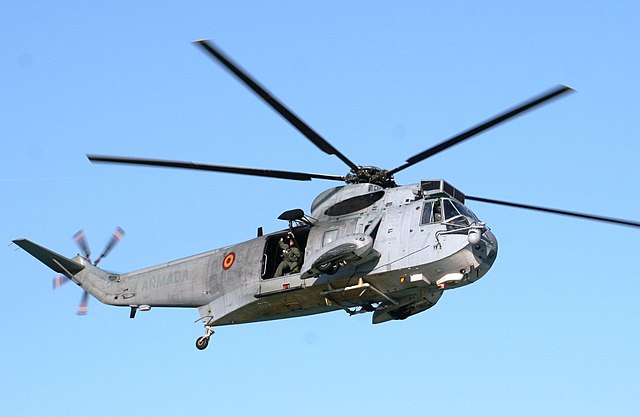
SH-3D in Armada color. Used for SAR, transport, laison, but more so for ASW warfare. This Anti-submarine warfare helicopter was developed for the U.S. Navy in 1978, with 73 built and two conversions from SH-3As.
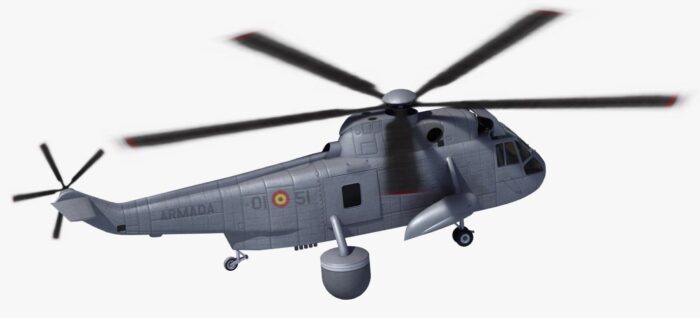
A variant of the legendary Sea King in Spanish service. This Airborne early warning version is unique to Spain.
AB-212 (HU-18)
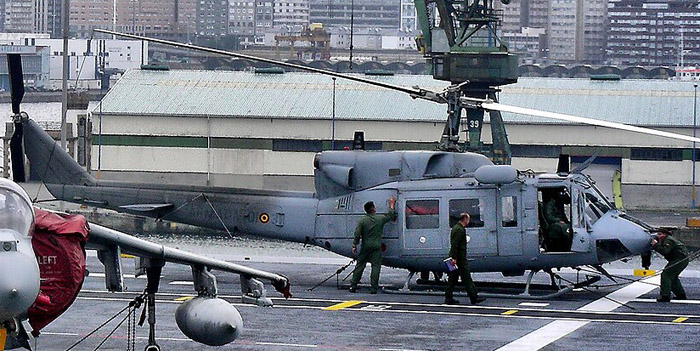
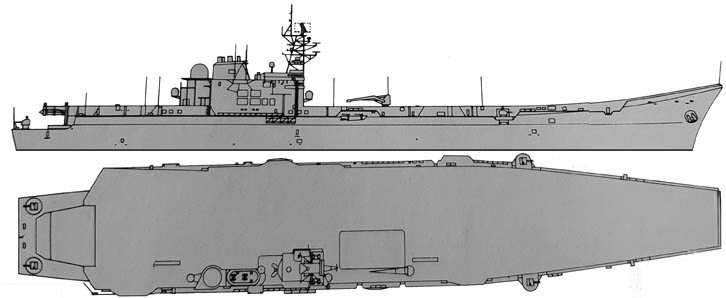
Conway’s rendition of the Prince de Asturias as completed.
⚙ specifications |
|
| Displacement | 15,912 tons standard, 16,700 tons loaded |
| Dimensions | 195.9 x 24.3 x 9.4 m (643 x 80 x 31 ft) |
| Propulsion | 1 shaft 2× Bazan-GE LM2500+ gas turbines (COGAG: 46,400 shp) |
| Speed | 26 knots (48 km/h; 30 mph) |
| Range | 6,500 nautical miles (12,000 km; 7,500 mi) at 20 knots (37 km/h; 23 mph) |
| Armament | 4× Meroka Mod 2B CIWS, 12× Oerlikon L120 20 mm AA |
| Sensors | SPS-52C/D 3D ASR, SPS-55 SSR, SPN-35A ACR, SPG-M2B FCRn RTN-11L/X MAWR, RAN 12 L TDR |
| Protection | Nettunel ECM, SRBOC, AN/SLQ-25 Nixie |
| Air group | AV-8B Matador VTOL, var. Helicopters |
| Air Facilities | Hangar, 46.5 m (153 ft) ski jump, 2 lifts |
| Crew | 830 (total); 600 ship crew, 230 air crew |
Career of Prince de Asturias 1988-2013
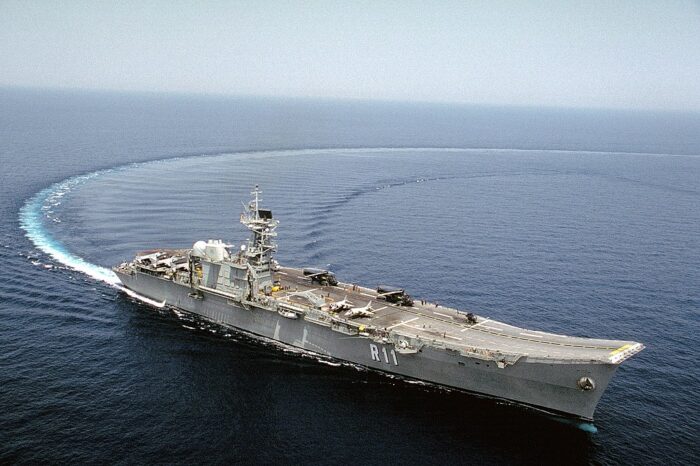
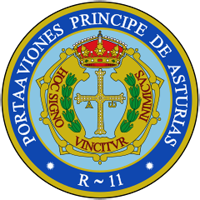 She was the third aircraft carrier in the history of the Spanish Navy, after the two Dédalo (Daedalus) one that supported the Al Hoceima Landing in 1925 and the other being the former USS Cabot. Initially she was to be named Almirante Carrero Blanco, a favorite under Franco but after he passed out and democratization of the country, this was changed afgter some discussions (Lepanto, España, Dédalo or Canarias) and chosen a week before launch. In Spain the Prince of Asturies is the equivalent in britain of the Prince of Wales.
She was the third aircraft carrier in the history of the Spanish Navy, after the two Dédalo (Daedalus) one that supported the Al Hoceima Landing in 1925 and the other being the former USS Cabot. Initially she was to be named Almirante Carrero Blanco, a favorite under Franco but after he passed out and democratization of the country, this was changed afgter some discussions (Lepanto, España, Dédalo or Canarias) and chosen a week before launch. In Spain the Prince of Asturies is the equivalent in britain of the Prince of Wales.
She was given her battle flag in a ceremony presided over by Juan Carlos I in Barcelona on May 28, 1989. For the event, a large naval parade was organized that included the presence of ships from many foreign navies. From then on she was part of Group-2 of the Naval Action Force, where together with the amphibious ships her mission was the projection of naval power on land. In those years, Spain was one of the few countries that had an air-naval group.
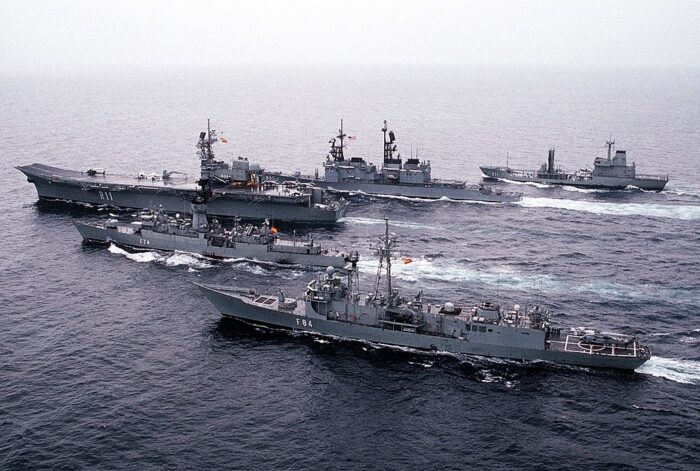
In June 1989, he had Felipe de Borbón y Grecia among his crew, during his training as a student ensign of the Navy.
NATO Exercise Display Determination ’91, from bottom to top, Prince of Asturias, USS Wasp, USS Forrestal, and HMS Invincible.
During the first Gulf War, in 1991, he participated in a naval operation with British, French, Italian and German units in the Mediterranean called Cadex ’91-1.14 From December 10 to 21, 1994 as part of UNPROFOR, he was the command ship of the naval operational group 81-01 in the Adriatic.
On June 28, 2005, he attended an international naval review in Portsmouth on the occasion of the second centenary of the Battle of Trafalgar, later traveling on October 21 to the place where the battle took place to lay a wreath to those who fought in the battle. .14 From February 6 to March 30, 2006, it participated, along with ships of various nationalities, in the GALIBER 07 deployment in Atlantic and Mediterranean waters.
Together with the Castilla, it made a visit to Lisbon in June 2008, with both ships calling at the Rocha Conde de Óbidos cruise terminal after having participated in the Loyal Mariner 08 maneuvers, along with 20 other ships from NATO countries.16 In March 2009, it participated in the NATO Loyal Mariner 09 maneuvers in the waters south of Sardinia, along with other Spanish units and units from 13 other countries.

U.S. Navy photo by Mass Communication Specialist 2nd Class Leonardo Carrillo
Between June 10 and 13, 2010, he participated in the commemoration of the centenary of French naval aeronautics along with the American ships USS Harry S. Truman and USS Normandy, the French Charles de Gaulle (R 91), Foudre (L 9011) and the Forbin (D620) and the British RFA Argus (A135).18 In March 2011, while participating in the NATO Noble Mariner maneuvers alongside ships from 20 countries,19 the Prince of Asturias was offered for deployment off the coast of Libya after the UN resolution authorizing a no-fly zone in that country,20 although finally, as naval means, an Álvaro de Bazán class frigate and a Galerna class submarine were chosen.
In May 2012 it was announced that the Navy Headquarters was studying paralyzing the aircraft carrier Príncipe de Asturias and two of the six frigates of the Santa María class as part of a drastic plan to save maintenance costs. Technically, it was a question of leaving these vessels in restricted activity, waiting for it to be possible to recover their full operation in the future. 21
Discharge and final destination
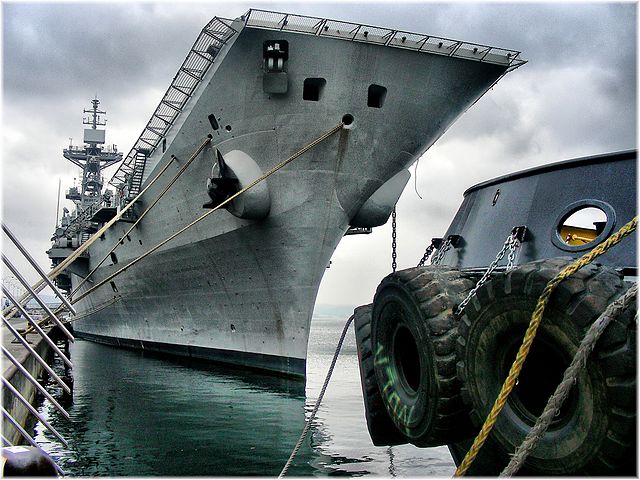
The Prince of Asturias moored at the La Graña naval base, in Ferrol in February 2013. The ship, about to be decommissioned, arrived at this base to have its ammunition and fuel removed.
Within the Modernization Plan of the Fleet Projection Group, it was planned to subject the aircraft carrier to a major upgrade in two phases: the first, within the CAVIMAR program, would consist above all of improving the ship’s habitability and its storage capacities and the like. took place in 2007, while the second would be much broader and would have had to affect a large number of different areas and systems of the ship, beginning once the Juan Carlos I had entered service. But the economic crisis of 2008-2013 It caused the second phase to be canceled and the aircraft carrier to be docked without activity at the Rota base facilities.
In October 2012, Mariano Rajoy’s government decided, due to the maintenance cost, to decommission the aircraft carrier, setting this for early 2013, after 25 years of service, and its subsequent scrapping at the Navantia facilities in Ferrol.
On February 6, 2013, the ship’s farewell ceremony took place in the waters of Rota, presided over by the then Prince of Asturias, Felipe de Borbón, by the Minister of Defense, Pedro Morenés and by the chief of staff of the Navy Jaime Muñoz-Delgado.23 After this ceremony, he left for Ferrol with a reduced complement of 220 people, where he arrived on the 8th of February to complete its disarmament and evaluation period, prior to its auction and subsequent scrapping.24 Four days later, it was transferred from the La Graña naval base, where it had left the remaining fuel in its tanks and other consumables, to the Navantia dock number 7 in Ferrol.25 On December 14, at the Ferrol Military Arsenal, the official discharge ceremony of the aircraft carrier from the Official List of Navy Ships (LOBA) was held, after all the material had been removed. usefulness of its interior, so the ship was waiting for its destination.
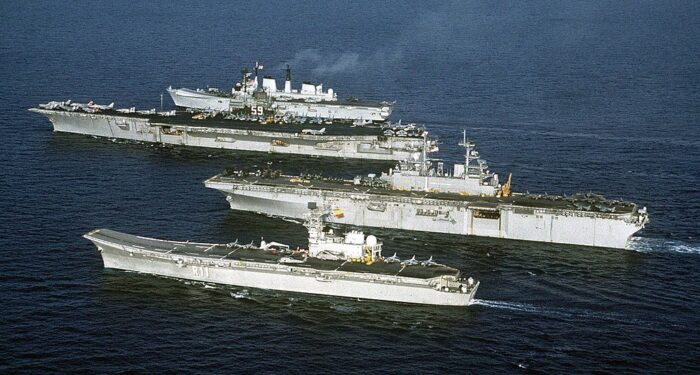
The search for navies interested in the ship was unsuccessful, and funds were sought to convert it into a museum ship. On December 16, 2015, the Official State Gazette published the auction of the ship with a starting price of 4.8 million euros.26 This auction took place on March 31, in which no reached no bid for that value. After three successive decreases of 15% as stipulated in the BOE, the price reached 2.9 million euros and due to the absence of a bidder, the auction was declared void.
On September 29, 2016, it was provisionally awarded to the joint venture formed by the Spanish company Surus Inversa and its Turkish partner for 2.4 million euros, to be dismantled at the facilities that the Turkish company has in Aliaga.28 The On August 9, 2017, she left for the Turkish port of Aliaga to be scrapped throughout 2018.3

In the briefing room and in the officers’ quarters, several shots of the film NAVY SEALS (1990) were filmed. And several helicopters from the 5th Squadron of the Embarked Air Unit (01-501,01-506,01-503 and 01-508) were used. To which they put a sticker with the word NAVY, covering the original (ARMADA).
This ship was located and a request was made to rent it to film a Hollywood film about a case of harassment of an officer in the United States Navy. Although the Spanish Navy initially agreed, it was finally not carried out when the Spanish learned that the United States Navy had denied their authorization to use their aircraft carriers. Finally, the film was never filmed due to a lack of useful exteriors. The Thai aircraft carrier HTMS Chakri Naruebet was built in the same shipyards, based on the Prince of Asturias design.
Read More/Src
Books
Flash Traffic: Farewell Principe de Asturias”. The Navy. Navy League of Australia
Forecast International. March 1998.
Conway’s all the world’s fighting ships 1947-95 p.432
Links
forecastinternational.com/
on navyrecognition.com/
on alojados.revistanaval.com/
on passarodeferro.com/
naval-technology.com
navypedia.org/
on es.wikipedia.org/
commons.wikimedia.org/
divsurg.afod-pofa.com
navweaps.com/
web.archive.org/ on panzertruppen.org
on english.elpais.com/
armada.defensa.gob.es/
haberturk.com/
lavozdigital.es/cadiz/
elpais.com/
lne.es/aviles/
Videos
Model Kits
Not much: Amateur Wargame Figures No. 5WYRQ69CQ | 1:700. That’s it. Scratchbuilt ones though.
on modelshipgallery.com/
on forummarine.forumactif.com
3D
None

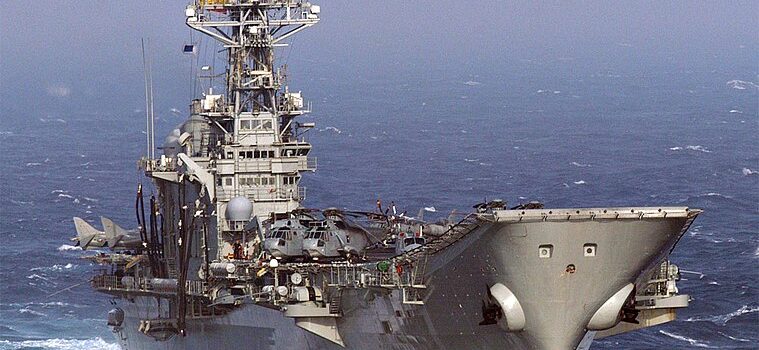
 Latest Facebook Entry -
Latest Facebook Entry -  X(Tweeter) Naval Encyclopedia's deck archive
X(Tweeter) Naval Encyclopedia's deck archive Instagram (@navalencyc)
Instagram (@navalencyc)





 French Navy
French Navy Royal Navy
Royal Navy Russian Navy
Russian Navy Armada Espanola
Armada Espanola Austrian Navy
Austrian Navy K.u.K. Kriegsmarine
K.u.K. Kriegsmarine Dansk Marine
Dansk Marine Nautiko Hellenon
Nautiko Hellenon Koninklije Marine 1870
Koninklije Marine 1870 Marinha do Brasil
Marinha do Brasil Osmanlı Donanması
Osmanlı Donanması Marina Do Peru
Marina Do Peru Marinha do Portugal
Marinha do Portugal Regia Marina 1870
Regia Marina 1870 Nihhon Kaigun 1870
Nihhon Kaigun 1870 Preußische Marine 1870
Preußische Marine 1870 Russkiy Flot 1870
Russkiy Flot 1870 Svenska marinen
Svenska marinen Søværnet
Søværnet Union Navy
Union Navy Confederate Navy
Confederate Navy Armada de Argentina
Armada de Argentina Imperial Chinese Navy
Imperial Chinese Navy Marinha do Portugal
Marinha do Portugal Mexico
Mexico Kaiserliche Marine
Kaiserliche Marine 1898 US Navy
1898 US Navy Sovietskiy Flot
Sovietskiy Flot Royal Canadian Navy
Royal Canadian Navy Royal Australian Navy
Royal Australian Navy RNZN Fleet
RNZN Fleet Chinese Navy 1937
Chinese Navy 1937 Kriegsmarine
Kriegsmarine Chilean Navy
Chilean Navy Danish Navy
Danish Navy Finnish Navy
Finnish Navy Hellenic Navy
Hellenic Navy Polish Navy
Polish Navy Romanian Navy
Romanian Navy Turkish Navy
Turkish Navy Royal Yugoslav Navy
Royal Yugoslav Navy Royal Thai Navy
Royal Thai Navy Minor Navies
Minor Navies Albania
Albania Austria
Austria Belgium
Belgium Columbia
Columbia Costa Rica
Costa Rica Cuba
Cuba Czechoslovakia
Czechoslovakia Dominican Republic
Dominican Republic Haiti
Haiti Hungary
Hungary Honduras
Honduras Estonia
Estonia Iceland
Iceland Eire
Eire Equador
Equador Iran
Iran Iraq
Iraq Latvia
Latvia Liberia
Liberia Lithuania
Lithuania Mandchukuo
Mandchukuo Morocco
Morocco Nicaragua
Nicaragua Persia
Persia San Salvador
San Salvador Sarawak
Sarawak Uruguay
Uruguay Venezuela
Venezuela Zanzibar
Zanzibar Warsaw Pact Navies
Warsaw Pact Navies Bulgaria
Bulgaria Hungary
Hungary

 Bundesmarine
Bundesmarine Dutch Navy
Dutch Navy Hellenic Navy
Hellenic Navy Marina Militare
Marina Militare Yugoslav Navy
Yugoslav Navy Chinese Navy
Chinese Navy Indian Navy
Indian Navy Indonesian Navy
Indonesian Navy JMSDF
JMSDF North Korean Navy
North Korean Navy Pakistani Navy
Pakistani Navy Philippines Navy
Philippines Navy ROKN
ROKN Rep. of Singapore Navy
Rep. of Singapore Navy Taiwanese Navy
Taiwanese Navy IDF Navy
IDF Navy Saudi Navy
Saudi Navy Royal New Zealand Navy
Royal New Zealand Navy Egyptian Navy
Egyptian Navy South African Navy
South African Navy






























 Ukrainian Navy
Ukrainian Navy dbodesign
dbodesign